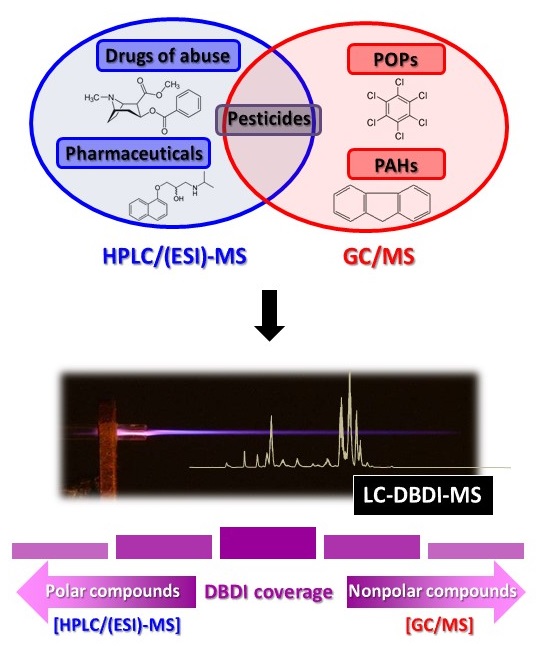Research
The field of activity comprises both basic and applied research in food and bioanalytics using hyphenated mass spectrometric techniques and high-resolution mass spectrometry.
The field of activity comprises both basic and applied research in food and bioanalytics using hyphenated mass spectrometric techniques and high-resolution mass spectrometry.
Lipids are a broad and important group of biomolecules. They play an important role in a variety of biochemical processes in the organism. Their functions are diverse and thus require a wide variety of structures of differing complexity. Important methods for the analysis of lipids are liquid chromatography (LC) coupled with high-resolution mass spectrometry (HRMS). Besides the separation of lipids based on their hydrophobic fatty acid residues using reversed phase (RP)-LC, Hydrophilic Interaction Liquid Chromatography (HILIC) is used for the separation of polar phospholipid classes. The phospholipid classes are separated according to their class specific polar head group. Recently, we are using two-dimensional (2D)-LC to broaden the range of lipids that can be separated. Especially online methods, in which the eluate of the first dimension is transferred directly to the second dimension, for example by a so-called heart-cut, increase the separation efficiency, but can also be used for sample preparation. An interesting combination here is the class specific separation of polar phospholipids in the first dimension using HILIC. The classes can then be examined more precisely by separation using RP-LC in the second dimension.
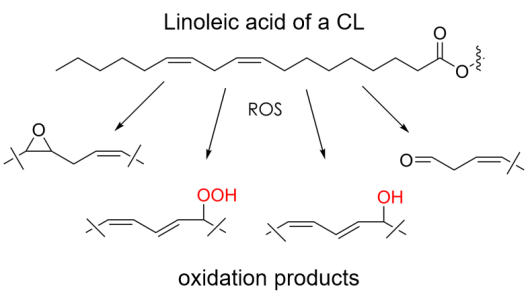
Cardiolipins (CL) are particular representatives of phospholipids, which in eukaryotic cells are only present in the mitochondria. They are almost exclusively present in the inner mitochondrial membrane (IMM) and ensure the general functionality of this cell organelle. In addition, CL play an important role in apoptosis. Unique to this class of lipids is the atypical dimeric structure and the associated four fatty acid residues. CL contain two phosphatidic acid (PA) units linked by glycerol. Each PA unit contains two partly different fatty acid units with variations in chain length and degree of saturation, resulting in a high structural diversity. In addition, the composition is specific for different tissues and organisms. For example, CL from bovine Heart consist mainly of linoleic acid residues, while in fish, a more diverse fatty acid profile can be found including higher unsaturated fatty acids. In addition to CL, their oxidation products are also of great interest. For example, the oxidation of CL by cytochrome c is a crucial step for intrinsic apoptosis by releasing pro-apoptotic factors from mitochondria into the cytoplasm. Frequently, the formation of monolysocardiolipins (MLCL), i.e. CL with loss of a fatty acid, is also the reason for the destabilization of IMM and consequently the dysfunction of oxidative phosphorylation, which can lead to an increased formation of reactive oxygen species (ROS). All this can lead to a lower CL concentration in IMM and is thus related to various diseases such as diabetes, heart failure and Parkinson's disease.
For the detection and profile analysis of CL and its (oxidized) metabolites by e.g. ROS, modern hyphenation techniques of LC-HRMS along with software-assisted data processing are essential. The use of 2D-LC systems furthermore allows the separation of coeluting species by a separation mechanism different from the first dimension. In addition to the frequently used normal phase (NP) and RP chromatography, HILIC is also used for the separation of CL.
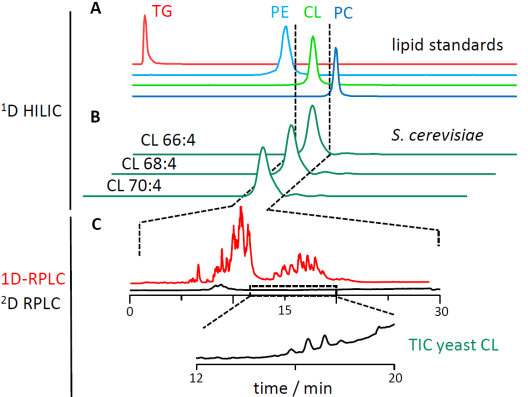
Lipids are a group of biomolecules with a broad variety of chemical structures. This renders them suitable for various kinds of tasks in a number of different organisms. Double bonds have an influence on lipids’ chemical, biochemical and biophysical properties. Since the localization of double bonds in lipids is still a difficult task regarding their structural diversity and possible complexities of available mixtures, the development of a new method addressing those challenges is required. For overcoming those challenges, the photochemical Paternò Büchi reaction, based on the binding of acetone to the double bonds, is a promising approach. Precise localization can be achieved due to diagnostic fragments observed in MS/MS experiments. A combination of a HPLC separation with an online reaction provides further information about the lipid structures, for instance, regarding constitutional isomers. In addition to that, a recording of spectra with reduced complexity and matrix effects can be enabled.
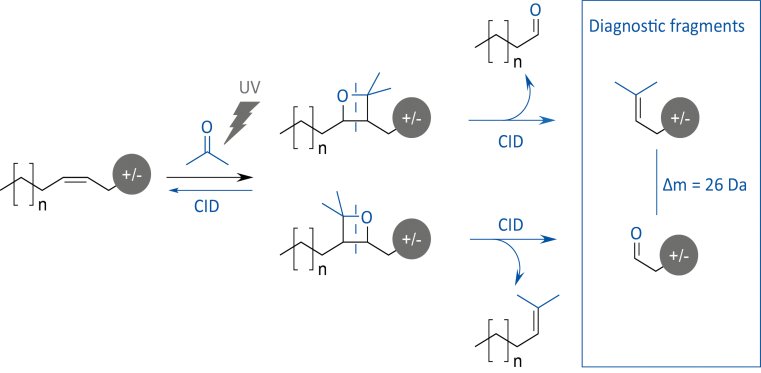
Modern coupling techniques of chromatographic separation methods with high-resolution mass spectrometry enables the acquisition of lipid data of complex biological samples in a very short analysis time. The processing of the generated multidimensional data sets with subsequent identification of lipids is the bottleneck regarding overall analysis times. Therefore, new algorithms and databases for the identification of various lipid classes are being developed. The developments are integrated into the open-source software MZmine 2 and thus made available to all users. A special focus is on glycolipids, MS/MS databases and the identification of oxidation and derivatization products. A visualization module based on the Kendrick mass defect serves as a supporting graphical evaluation tool, which displays chromatographic information in a third dimension.
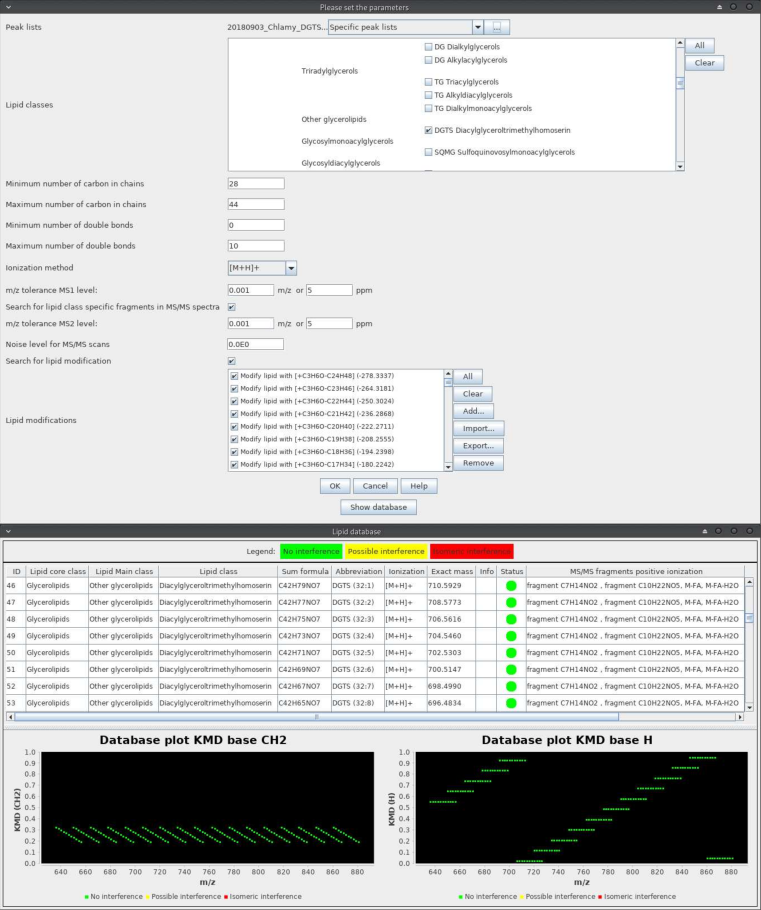
In recent years, the discussion about the remaining oil stocks and the sustainable utilization of raw materials increases. In the field of biocatalysis, renewable raw materials are a promising alternative for the production of chemical and biotechnological products. Surfactants, which are part of detergents, pharmaceutics, cosmetics as well as food products, are mainly formed by petrochemical processes. Biosurfactants like rhamnolipids or liamocins from the class of glycolipids show a high work efficiency, a good biodegradability and a poor toxicity compared to commercial surfactants.
Rhamnolipids are formed by Pseudomonas species as secondary metabolites and show a wide structural diversity. So far, the focus is on the production of those glycolipids. Based on liquid chromatography/mass spectrometry (LC/MS), tandem mass spectrometry (MS/MS) and capillary gas chromatography/mass spectrometry (capillary GC/MS) instrumental analytical methods should be developed for the analysis and structure elucidation of the biosurfactants.
Liamocins, which are formed by the fungus Aureobasidium pullulans, show an antibacterial activity against Steptococcus species and an anticancer activity against lung cancer and cervical cancer. Based on LC/MS as well as MS/MS experiments, analytical methods for the separation and structure elucidation should be developed in our research group.
The two analytical challenges are performed in cooperation with Prof. Dr. Lars M. Blank and Dr. Till Tiso (Institute of Applied Microbiology, RWTH Aachen).
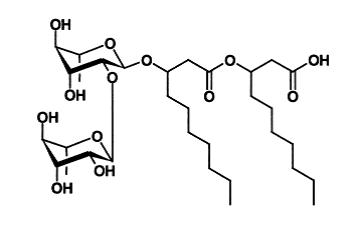
Capillary ion chromatography (Cap-IC) hyphenated with conductivity detection (CD) and mass spectrometry (MS) is applied for identification and quantification of various metabolites. Metabolites which are examined are for example short-chain fatty acids (SCFA) and oxalic acid. By means of the developed methods matrices like urine and faeces samples of mice and Arabidopsis thaliana samples are analysed in respect of biological and medical issues.
Based on hydrophilic interaction liquid chromatography (HILIC) and ion exchange chromatography (IC) targeted separation methods hyphenated with mass spectrometry are developed to identify and quantify polar metabolites.
One of the analytical challenges is the analysis of pyoverdines. These small, yellow-green fluorescent molecules are synthesized by Pseudomonas bacteria for the acquisition of iron. Because of their high affinity to iron(III), these siderophores are able to form very stable complexes and withdraw iron from the environment. Due to this fact, the iron chelating molecules are of interest in biological and medical research.
Because of the characteristic structure consisting of a chromophoric unit linked to an acyl side chain and a peptide sequence and their polar character, pyoverdines can be separated and characterized by HILIC. High-resolution mass spectrometry and fragmentation experiments (MS/MS experiments) facilitate structural elucidation. The purpose of our research is the structure elucidation of previously unknown compounds. Additional information is obtained by isotopic labeled sample material and hydrolysis experiments to elucidate the individual amino acids of the peptide chain.
The determination of pesticide residues in plant foods is of great importance for consumer and health protection. More than 1000 different active ingredients are used worldwide in plant cultivation alone. The persistence of pesticides represents a potential health hazard.
In addition, other organic substances are continuously released into the environment (surfactants, hormones, pharmaceuticals, personal care products, etc.), which are referred to as "emerging contaminants" and may lead to health impairments in the future.
As a result, multi-component methods are required for residue analysis in food and screening for emerging contaminants in the environment, which cover the broadest possible spectrum of analysis. Especially instrumental couplings from efficient separation and highly selective mass spectrometric detection methods are able to meet these requirements. In recent years, liquid chromatography-mass spectrometry (LC-MS) has increasingly established itself in food analysis alongside the proven gas chromatography-mass spectrometry (GC-MS). However, so far there is no universal ionization method that can efficiently ionize both nonpolar and polar substances. As a result, alternative ionization techniques are to be developed and used. A promising approach is microplasma-based discharges, which are being developed in the working group of PD Dr. Joachim Franzke (Leibniz Institute for Analytical Sciences - ISAS - e.V., Dortmund). In cooperation, these techniques will be characterized and applied in the trace analysis of pollutants.
